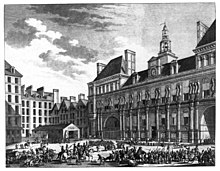Paris Commune (French Revolution)

Hôtel de Ville, Paris, during the French Revolution
The Paris Commune during the French Revolution was the government of Paris from 1792 until 1795. Established in the Hôtel de Ville just after the storming of the Bastille, it consisted of 144 delegates elected by the 48 divisions of the city. The Paris Commune became insurrectionary in the summer of 1792, essentially refusing to take orders from the central French government. It took charge of routine civic functions but is best known for mobilizing extreme views and actions among the people and for its campaign to dechristianize the churches and the people. It lost much power in 1794 and was replaced in 1795.[1]
The first mayor was Jean Sylvain Bailly; he was succeeded on November 1791 by Pétion de Villeneuve after Bailly's unpopular use of the National Guard to disperse a riotous assembly in the Champ de Mars (17 July 1791).
In 1792, the Commune was dominated by those Jacobins who were not in the Legislative Assembly due to the Self-Denying Ordinance.
On the night of 9 August 1792 a new revolutionary Commune, led by Georges Danton, Camille Desmoulins and Jacques Hébert took possession of the Hôtel de Ville; the next day insurgents assailed the Tuileries, where the royal family resided. During the ensuing constitutional crisis, the collapsing Legislative Assembly of France was heavily dependent on the Commune for the effective power that allowed it to continue to function as a legislature. The all-powerful Commune demanded custody of the royal family, imprisoning them in the Temple fortress. A list of "opponents of the Revolution" was drawn up, the gates to the city were sealed, and on 28 August the citizens were subjected to domiciliary visits, ostensibly in a search for muskets.
It was not until 1792 that the government had a formal cabinet in place, with the appointment of the Ministers of the French National Convention and the decision of the Commissioners of the Committee of Public Safety in 1794 to take charge of administrative departments.
The government of the republic was succeeded by the French Directory in November 1795.
Notes
^ François Furet and Mona Ozouf, eds. A Critical Dictionary of the French Revolution (1989), pp 519-28
This France-related article is a stub. You can help Wikipedia by expanding it. |
